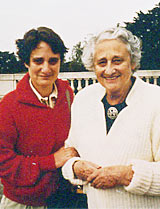Best Length for Documentary Films
How long should your documentary be? I get this question a lot in my work as an editor and story consultant. Frankly, I think the majority of documentaries that were not shaped by experienced editor, story consultant or a supervising executive at a broadcast outlet such as HBO or Showtime are too long. And the problem with “too long”, of course, is that your audience begins to glaze over or feel restless, and you, my dear director, have lost the opportunity to leave them wanting more.
So how long should a documentary be? As long as it needs to be. I first heard this truism from Academy award-winning editor Deborah Hoffman, whose own personal documentary, Complaints of a Dutiful Daughter, was 44 minutes long. This unconventional length, which raised many eyebrows, turned out to be the perfect runtime for showing the film at community events and in university classes. And subsequently the film did very well in sales, making it a top revenue producer for its distributor, Women Make Movies.
Unless you are under the constraints of a predetermined runtime–for example, a 56:40 PBS length–I suggest that directors listen closely to their editor, their story consultant, and the feedback gathered at rough cut screenings. Ultimately you may decide to cut various lengths–a longish version for theatrical, a tighter version for television and an even shorter version for the web.
Why do so many directors tend to make their film too long? Famously, directors “fall in love” with scenes and can’t bear to cut them. This unfortunate, passionate attachment can also be shared by editors who spend too much time with the footage. Having been one, I know. In these cases, an outside advisor can provide fresh perspective. Listen to them!
Another reason inexperienced filmmakers create long documentaries is that they haven’t developed the discipline to weed out ideas that are tangential, repetitive, or run “fat,” often in the form of bloated soundbites. My mentor Deborah Hoffman was a genius at running her pen through unnecessary words in an interview bite of a rough cut transcript. It’s a great discipline to develop.
So what can you do if test viewers think you’re rough cut is too long? First look carefully at your characters and see if any of them are repeating the role of another character. If so, make the hard decision to cut one of them. Hire an outside consultant to work with you to cull ideas in topic-based films that really don’t serve your film’s central thesis. Often essay-style documentaries, which are structured around ideas rather than a character’s quest, overwhelm the viewer with too much information. Remember, you’re not making a book.
If you’re making a character-driven documentary, every scene must serve your protagonist’s quest or a related subplot. The exception is if you are weaving in an essay whose points must then be motivated by your protagonist’s actions. A great example of how to do this can be seen in the documentary Supersize Me by Morgan Spurlock. Spurlock could have loaded his food activist film with even more research about the ill effects of fast food, but he seems to have found just the right balance, leaving the audience wanting more of his nutritional insight.
For more insight into editing tight and compelling documentaries, check out the online class “Editing the Character-Driven Documentary” at https://newdocediting.com/products/. You’ll find Module #4 especially helpful in creating a cohesive, lean structure.
